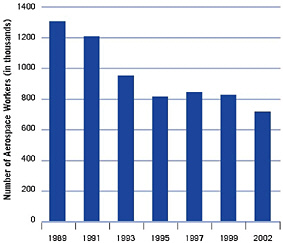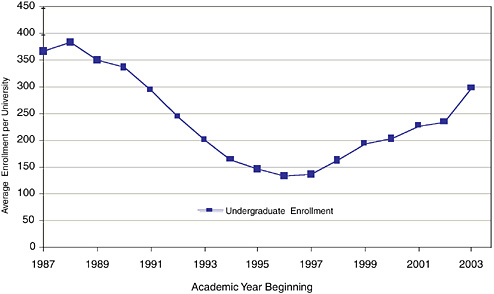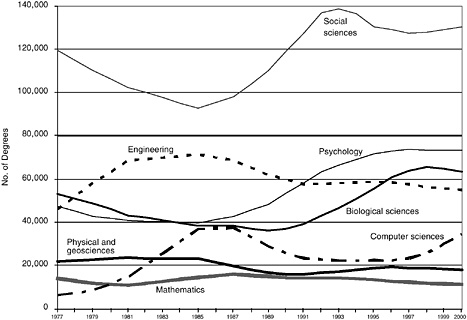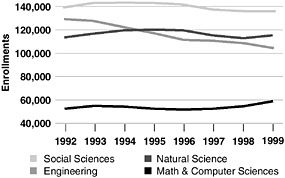4
Enabling a More Robust Aerospace Workforce
INTRODUCTION
One of the committee’s tasks was to suggest initiatives that ensure a more robust aerospace science and engineering workforce will be available to develop hypersonic propulsion, access to space, and space technology to meet civilian and warfighter needs over the next 20 years.
The Hart-Rudman Commission illustrated the relation between U.S. national security and the need for a national effort in aerospace science and technology (S&T) that is supported by a well-educated aerospace workforce. The report stated in blunt terms,
[t]he harsh fact is that the U.S. need for the highest quality human capital in science, mathematics, and engineering is not being met. . . . This [situation] is not merely of national pride or international image. It is an issue of the utmost importance to national security. In a knowledge-based future, only an America that remains at the cutting edge of S&T will sustain its current world leadership. . . . Complacency with our current achievement of national wealth and international power will put all of this at risk. (USCNS, 2001)
America’s aerospace leadership depends on the products of aerospace, which in turn depend on a continuous supply of scientists and engineers engaged in work funded from the 6.1 to 6.7 level. At present, we do not have a national aerospace consensus to help guide policies and programs. This contributes to unfocused federal and industrial investments spread over a variety of long-range research programs and their associated aging infrastructure. The DoD has based its continuing military dominance on technological superiority rather than on maintaining large numbers of personnel in the uniformed services. This is a strategy that has worked well to now. However, our current military dominance was derived from long-term investments in S&T made in the 1950s through the 1970s by the DoD and other federal agencies, including the National Aeronautics and Space Administration (NASA). Defense capabilities that are now entering service are based on the S&T investments of the 1980s and 1990s. There is concern that
[t]he focus of the current DoD S&T program is primarily on incremental improvements in current capabilities . . . and does not place sufficient emphasis on innovative technology initiatives leading to entirely new military capabilities. (DSB, 2000)

FIGURE 4-1 U.S. and EU aerospace employment, 1980-2000. SOURCE: CFUSAI, 2002.
In the long term, this situation is untenable. As other nations build their own aerospace workforces, the current balance will inevitably shift, eroding or even ending our military advantage. This is already happening in the commercial aerospace sector.
Our policymakers need to acknowledge that the nation’s apathy toward developing a scientifically and technologically trained workforce is the equivalent of intellectual and industrial disarmament and is a direct threat to our nation’s capability to continue as a world leader. (CFUSAI, 2002)
The following are some of the trends characterizing the current state of the aerospace workforce of the United States:
-
A decline of 60 percent from the 1964 peak in the overall federal investment in R&D as a percentage of GDP, in particular for the physical sciences and engineering, even though the DoD depends heavily on the application of these fields to develop new warfighting and peacekeeping capabilities.
-
International competitors, including the European Union, are gaining (Figure 4-1). The U.S. share of the world’s aerospace markets as measured by annual revenue fell from over 70 percent to below 50 percent in 2000 (CFUSAI, 2002).
-
Because of industry layoffs that were due to the end of the Cold War and subsequent mergers, the nation has lost over 600,000 scientific and technical aerospace jobs since 1989, with 100,000 lost since the attacks of September 11, 2001 (Figure 4-2). Many of those laid off move on to other industries, which include nontechnical industries like banking and entertainment (CFUSAI, 2002; NASA, 2003a).
-
The average age of the aerospace worker in industry is 44. The average age is 51 at NASA and 53 in the DoD.1 Over 26 percent of the aerospace workforce will be eligible for retirement in 2008 (CFUSAI, 2002).
-
The proportion of aerospace workers 30 years old or younger dropped from 18 percent in 1987 to 6.4 percent in 1999 (AIA, 2001). In part this is due to the cyclical nature of major aerospace programs, which caused a general decline in the number of American-born youth pursuing an education in aerospace engineering at the undergraduate level (Figure 4-3) and the graduate level (Figure 4-4) (McLaughlin, 2002; Grossman, 2002; CFUSAI, 2002; NASA, 2003a). Another reason
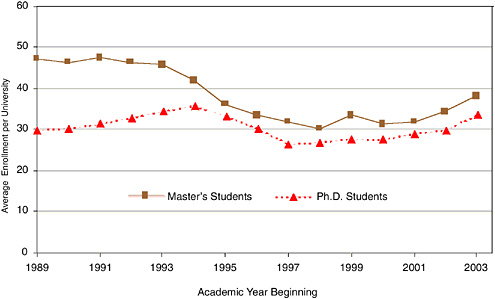
FIGURE 4-4 Average aerospace graduate enrollment per university (37 universities), 1989-2003. SOURCE: McGlaughlin, 2002, as updated via e-mail.
-
may be the failure of mathematics and science education in the K-12 system (Figure 4-5), which may be a more pertinent reason for declining engineering enrollments and not unique to the aerospace discipline (Figures 4-6 and 4-7).
The U.S. workforce has always benefited from international S&E talent (Figure 4-8). However global competition for this talent is intensifying. The number of doctorates earned by U.S. citizens in engineering has decreased from 2,514 in 1970 to 2,206 in 2000. At the same time, the number of doctorates earned by foreign students on temporary visas grew from 471 in 1970 to 2,444 in 2000. An increasing and significant percentage of these highly educated scientists and engineers enter the
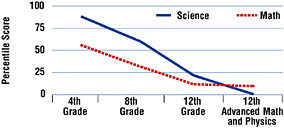
FIGURE 4-5 Science and math performance of U.S. students relative to foreign students, 2001. SOURCE: CFUSAI, 2002.
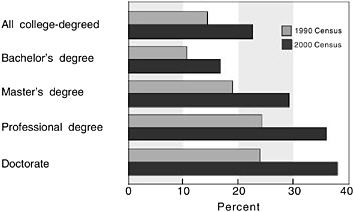
FIGURE 4-8 Share of foreign-born scientists and engineers in U.S. S&E occupations by degree level, 1990 and 2000. SOURCE: NSB, 2003.
-
aerospace workforce of their home countries; we are educating our own competition. Many of those who do stay in the U.S. cannot obtain security clearances required for NAI-relevant aerospace positions. As a result, a considerable number of scientists and engineers educated in our universities do not or cannot contribute to this nation’s aerospace efforts.
NASA and DoD representatives presented to the committee their approaches to aerospace workforce development. Though efforts are being made to address workforce concerns, the committee believes these are insufficient. The committee believes what is really needed to address the majority of our workforce challenges is a clearly stated national aerospace consensus that focuses long-term federal and industrial investments on projects of strategic interest. This would include establishing a modern version of the National Defense Education Act of the Sputnik era that could be coordinated through an interagency task force. The benefits would cascade throughout the federal, industrial, and educational systems. A national aerospace consensus with consistent and long-term funding would mitigate the cyclical nature of hirings and layoffs and foster the creation of stable, career-oriented jobs of strategic importance. This, in turn, with the aid of an interagency task force, would attract high-quality undergraduate and graduate students who were inspired as K-12 students. Evidence of the effect of national efforts and the corresponding increase in funding on undergraduate and graduate education can be seen in Figures 4-3 and 4-4, respectively. It is no coincidence that increases in enrollment in aerospace programs coincided with increases in DoD spending and industry demand in the late 1980s and those beginning in the late 1990s.
The next two sections in this chapter discuss the two findings of the committee on the aerospace workforce and the respective recommendations. Finding 4-1 explains the DoD and NASA attempt to address the problem of the rapidly aging aerospace workforce and the resulting loss of technical knowledge by implementing a human capital management system. The discussion that follows Finding 4-2 explains the attempts that are being made to address education of the future aerospace workforce through basic research and collaboration between universities, industry, and government laboratories.
REINVIGORATING THE WORKFORCE
Finding 4-1. As mentioned in the introduction, the average age of the aerospace worker (industry, NASA, and DoD) is 49, and approximately 26 percent of this same aerospace workforce will be eligible for retirement in 2008. Upon their retirement, these aerospace workers will take with them specialized knowledge accumulated over decades. Loss of technical knowledge is most acute in the air-breathing hypersonics community. As a member of the NAI, NASA is developing a stopgap measure that will implement an integrated agency-wide approach to human capital management. This approach is designed to attract and maintain a workforce that is representative of the nation’s diversity and includes the competencies that NASA needs to deliver sustained levels of high performance that its challenging mission requires (NASA, 2003a). The DoD works to identify mission-critical occupations and competencies needed in the current and future workforce and to develop strategies to identify, recruit, and retain a high-performing workforce (OPM, 2004).
Discussion 4-1. NASA’s personnel reduction impacted its younger staff more severely. During the start of the NASA downsizing in 1993, the number of S&T workers under the age of 30 was nearly double the number of those over 60. At the conclusion of the downsizing, the number of personnel under the age of 30 was one-third the number of those over 60. Individuals with critical skills were lost (NASA, 2003a). In addition, almost 15 percent of NASA’s workforce is eligible for retirement now, and 25 percent is eligible within 5 years. Some core competencies can easily be lost with the retirement of only a few individuals. (This is true within both industry and the DoD.) To address this and other workforce trends, NASA formed the agency-wide Strategic Human Capital Plan and the Strategic Human Capital Implementation Plan (NASA, 2003a; NASA, 2003b). These plans are meant to identify those civil servants needed for mission-critical competencies that NASA must have in-house and to implement initiatives that capture corporate knowledge in an effective and systematic way from those who are retiring from the organization.
NASA’s approach does not address the long-term problem the nation faces in the 21st century. To maintain aerospace leadership, the United States must continue to have a highly skilled, stable, secure, and growing aerospace workforce. Many young Americans, however, are rejecting careers in aerospace in favor of more lucrative professions. Undergraduate and graduate students must find a rewarding future in aerospace.
Students interested in research see the prospect of low-paid apprenticeships, training that requires a decade or more, modest stipends for graduate and postdoctoral students, who are often in their mid-30s, and limited job opportunities. More importantly, prospects for autonomous research positions in academia and related research-intensive employment opportunities that most would-be scientists aspire to at the end of their long road are uncertain and increasingly slim (Zumeta and Raveling, 2002). Anecdotal evidence points to faculty having particular difficulty retaining students in air-breathing hypersonics. If one mentions the exciting advances that have come out of the joint DoD-NASA National Aerospace Plane (NASP) program—NASA’s X-33, X-34, and X-37, and the DARPA affordable rapid response missile demonstrator (ARRMD) (DDR&E, 2003)—it will be pointed out that all of the projects were canceled and not one of the X vehicles has flown.
Recommendation 4-1a. The aging workforce problem is one shared by all of aerospace and cannot be addressed by NAI alone, but NAI can contribute to the solution. An aerospace workforce pillar should be established in the NAI, along with the air-breathing hypersonics, space access, and space technology pillars. This workforce pillar can assist in a long-term national effort to coordinate all aerospace interests with consistent and long-term funding, as recommended in the introduction to this chapter. In the long term, an aerospace workforce pillar would allow much greater flexibility, coordination, and collaboration between industry, government, and universities than are
presently found in the URETIs. As an added benefit, the work could be managed from one office and coordinated with the efforts of the interagency task force, also proposed in the introduction to this chapter.
Recommendation 4-1b. The NAI pillar embodied in Recommendation 1a should exercise creativity and innovation to form extensive cooperation between academia, industry, and federal agencies to preserve the aging workforce’s technical knowledge. For example, the science, mathematics, and engineering (SME) educational programs that are funded by the DDR&E (EDUGATE, 2004) can be designed so that older aerospace workers can exchange knowledge and experience with local universities. Also, NASA and the DoD could augment their civil service and military personnel with an equal number of university, nonprofit, and industry personnel (NRC, 2001). This term-limited mixing in of top industry and academic talent would provide DoD employees with broader exposure to new ideas and help preserve DoD corporate memory.
Recommendation 4-1c. In the short term, NASA should be allowed to implement some of the human capital legislative options to address the aging workforce problem, as detailed in Appendix B of the Strategic Human Capital Implementation Plan (NASA, 2003b).
Recommendation 4-1d. A detailed study on the size of the S&E workforce required to meet future needs of the NAI should be commissioned after the initiative’s long-term goals and funding have been solidified.
UNIVERSITY RESEARCH, ENGINEERING, AND TECHNOLOGY INSTITUTES
Finding 4-2. The NAI recognizes that a balanced investment portfolio, from basic research to technology demonstration, is essential to fulfilling its goals and to countering the previously mentioned trends in aerospace workforce education (DDR&E, 2003). As a response, two URETIs have been jointly funded by the DoD and NASA (DDR&E, 2003).
Discussion 4-2. The two URETIs are led by the University of Maryland,2 investigating third-generation reusable launch vehicles, and the Georgia Institute of Technology, investigating aerospace propulsion and power for NASA’s long-term aerospace enterprise goals (Zinn, 2003). From information obtained by the committee, the URETIs include undergraduate and graduate student collaboration with university and industry partners and access to national facilities, including the NASA Glenn Research Center, the NASA Langley Research Center, the NASA Marshall Space Flight Center, the Air Force Research Laboratory, the Naval Air Warfare Center, and the Arnold Engineering Development Center. The URETIs address student research symposia, scholarships and fellowships, K-12 outreach programs, outreach to women and underrepresented minorities, and exchange of faculty, industry, and NASA researchers. Most importantly, the basic research aligns fully with the NAI goals of developing reusable vehicles for space access.
In general, URETIs are attractive from the perspective of NASA and the DoD as they are relatively easy to manage and can make considerable progress in getting new research off the ground by attempting to provide the critical mass of students, the needed cross-fertilization between university, industry, and government researchers, and dependable multiyear funding. However, there are drawbacks to applying the URETI model to the NAI components, especially in the development of air-breathing hypersonic launch vehicles.
-
The NAI-affiliated URETIs operate on a winner-take-all basis. By forming these two URETI centers, NASA and the DoD have provided the faculty with the largest share of support in the area of air-breathing hypersonics. These two URETI centers cannot, however, provide the entire solution to the basic science problems inherent in hypersonics. The aerospace community has a paucity of experts in the complex problems associated with air-breathing hypersonics and should not exclude those not affiliated with member universities.
-
Funding for NAI URETIs, at $3 million per year, is not sufficient to form a critical mass of faculty and students to tackle the major research problems in reusable launch vehicles.
-
The NAI URETIs may be working on an overly difficult problem. The development of air-breathing launch vehicles is the most difficult of the NAI components. URETIs are usually funded for a 5- to 7-year period with the option of renewal. This is too short a time period to demonstrate significant progress in the hypersonics problem.
-
Both of the two NAI-selected URETIs appear to have K-12 outreach programs in their charters, but no matter how great the effort, they will have a limited, local influence. The NAI needs a much broader range of academic institutions from which to draw its workforce.
Recommendation 4-2a. The NAI should clearly articulate a long-term commitment to reusable launch vehicle research. Adequate and consistent federal R&D funding to this problem is far more important than management convenience. Funding concerns can be mitigated by collaboration with other science and engineering fields. Most of the elements that must be addressed in the NAI require a multidisciplinary approach, using tools from computational and experimental fluid dynamics, uncertainty analysis, MDO, and materials science. Advances made with any of these tools will benefit all of S&T.
Recommendation 4-2b. NAI should encourage lifelong learning and individualized instruction, especially in government laboratories, to attract and retain aerospace workers (NRC, 2003). This can most easily be done through existing education programs that are already funded by DDR&E (EDUGATE, 2004). These programs can be expanded beyond their respective directorates and centers to other NAI-relevant laboratories.
Recommendation 4-2c. In the near term, the NASA-funded URETI led by the University of Florida on third-generation reusable launch vehicles should also be affiliated with the NAI (UF, 2003).
Recommendation 4-2d. In the near term, the URETI concept should be modified and expanded to form a critical mass of faculty and students in the air-breathing hypersonics component of NAI without excluding acknowledged experts in the field. For example, university centers of excellence (ARL, 2004) could be formed around experimental and computational facilities or core expertise through competitive grants to individual investigators.
Recommendation 4-2e. In the near term, the NAI should establish specific graduate fellowship and undergraduate scholarship programs with outreach to women and minority groups that are underrepresented in aerospace.
Recommendation 4-2f. In the near term, funds should be added to existing high school and undergraduate internship and faculty fellowship programs at NASA and DoD laboratories that work on NAI-relevant research (EDUGATE, 2004; ASEE, 2004). This would give high school students and aerospace undergraduates across the nation exciting hands-on experience, often lacking in many curricula. These same interns could also be charged with becoming “engineering
ambassadors” in secondary school endeavors (UA, 2003, 2004; KSU, 1998). Faculty members would carry their experience back to the classroom.
REFERENCES
Published
AIA (Aerospace Industries Association). 2001. Attracting and Retaining Qualified Personnel in the Aerospace Industry.
ARL (Army Research Laboratory). 2004. Partnerships. Program available at http://www.arl.army.mil/main/Partnerships/default.cfm?Action=partnerships&header=YES. Accessed on March 24, 2004.
ASEE (American Society for Engineering Education). 2004. Program available at http://www.asee.org/fellowship/default.cfm. Last accessed on March 24, 2004.
CFUSAI (Commission on the Future of the United States Aerospace Industry). 2002. Final Report of the Commission on the Future of the United States Aerospace Industry. Available at http://www.aerospacecommission.gov/AeroCommissionFinalReport.pdf. Accessed on December 23, 2003.
DDR&E. 2003. The National Aerospace Initiative Office, Congressional Report on the National Aerospace Initiative: In Response to the Senate Armed Services Committee Report Accompanying the National Defense Authorization Act for Fiscal Year 2004 (S.R. 108-46), September.
DSB (Defense Science Board). 2000. Letter Report on the Adequacy of the DoD Science & Technology (S&T) Program. Available at http://www.acq.osd.mil/dsb/letter.pdf. Accessed on March 24, 2004.
EDUGATE. 2004. Welcome to Edugate webpage. Program available at http://web.lmi.org/edugate/information.html. Accessed on March 24, 2004.
Grossman, B. 2002. Aerospace Engineering Enrollment and Employment Trends. Available at http://www.aerospacecommission.gov/051402testimony/grossman.pdf. Accessed on March 24, 2004.
KSU (Kansas State University). 1998. New engineering ambassadors ready to visit local high schools. eCollegian 102(108). Available at http://www.kstatecollegian.com/issues/v102/sp/n108/news/cam-ambass-williams.html. Accessed on March 24, 2004.
NASA (National Aeronautics and Space Administration). 2003a. NASA Strategic Human Capital Plan. Available at http://nasapeople.nasa.gov/hcm/Agency_SHCP-Final1.pdf. Accessed on March 24, 2004.
NASA. 2003b. Strategic Human Capital Implementation Plan. Available at http://nasapeople.nasa.gov/hcm/Agency_SHCPFinal2.pdf. Accessed on March 24, 2004.
NRC (National Research Council). 2001. Review of the Future of the U.S. Aerospace Infrastructure and Aerospace Disciplines to Meet the Needs of the Air Force and the Department of Defense. Washington, D.C.: National Academy Press.
NRC. 2003. Envisioning a 21st Century Science and Engineering Workforce for the United States: Report to the Government-University-Industry Research Roundtable. Washington, D.C.: The National Academies Press.
NSB (National Science Board), Committee on Education and Human Resources. 2003. The Science and Engineering Workforce: Realizing America’s Potential. Available at http://www.nsf.gov/nsb/documents/2003/nsb0369/start.htm. Accessed on March 24, 2004.
OPM (Office of Personnel Management). 2004. Strategic Management of Human Capital. Program available at http://www.opm.gov/Strategic_Management_of_Human_Capital/index.asp. Accessed on March 24, 2004.
UA (University of Arizona), College of Engineering and Mines. 2003. Engineering ambassadors. Arizona Engineer 26(2): 3.
UA, College of Engineering and Mines. 2004. Community Outreach: Engineering Ambassadors Webpage. Available at http://www.engr.arizona.edu/2_CO/engamb.htm. Accessed on March 24, 2004.
UF (University of Florida). 2003. Institute for Future Space Transport. Program available at http://www.mae.ufl.edu/ureti. Accessed on March 24, 2004.
USCNS (United States Commission on National Security/21st Century). 2001. Roadmap for National Security: Imperative for Change. The Phase III Report. Available at http://www.nssg.gov/PhaseIIIFR.pdf. Accessed on March 24, 2004.
Zumeta, W., and J.S. Raveling. 2002. Attracting the best and brightest. Issues in Science and Technology. Available at http://www.evansuw.org/FAC/Zumeta/pdf/attracting_the_best.pdf. Accessed on March 24, 2004.
Unpublished
McLaughlin, D.K. 2002. ADCA/AIAA Aerospace Engineering Enrollment Survey, Fall 2001. Presented by Dennis K. McLaughlin at the AIAA Aerospace Sciences Meeting, Reno, Nevada. January.
Zinn, B.T. 2003. NASA/DoD UAPT Program Overview. Briefing by Ben Zinn, Georgia Institute of Technology, at NASA Glenn Research Center. Available at http://www.asdl.gatech.edu/teams/ureti/Combust_Pres/GT_URETI_Program_GRC_Visit.pdf. Accessed on March 24, 2004.

